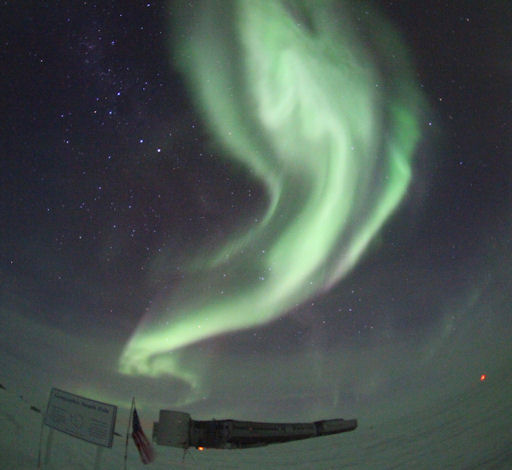STILL WAITING FOR THE CME: The CME launched toward Earth by the July 12th X-flare has not yet arrived. However, we are still within the forecast window set by analysts at the Goddard Space Weather Lab. The cloud should hit at 09:17 UT plus or minus 7 hours on Saturday, July 14th. Weekend auroras are likely. Aurora alerts: text, voice.
SUNDAY MORNING SKY SHOW: Set your alarm for dawn on Sunday morning, July 15th. Venus, Jupiter and the crescent Moon are gathering for a bright three-way conjunction in the eastern sky before sunrise. Must-see! [video] [photos]
HOT COMET: Periodic comet 96P/Maccholz is passing by the sun today deep inside the orbit of Mercury. At closest approach, the icy visitor from the outer solar system will be less than 12 million miles (0.13 AU) from the solar surface. Coronagraphs onboard the Solar and Heliospheric Observatory are monitoring the encounter:
"Discovered in 1986, Comet 96P/Machholz is a fascinating comet that has passed through SOHO coronagraph images four times now," says Karl Battams of the Naval Research Lab. "It's not a huge comet but it is very photogenic, and puts on quite a display with its beautiful dusty tail."
In an essay posted on his web site, Battams explains why the comet is so fascinating. Many researchers suspect 96P/Machholz is not a native of our solar system; some chemical evidence suggests it came from another star. Also, 96P/Machholz appears to be dynamically related (that is, the comet's orbit is related) to a diverse collection of other objects in the solar system including asteroid 2003 EH1 and the Quadrantid, Southern Delta Aquariid, and daytime Arietid meteoroid streams. All of these things--the asteroid, the comet, and the meteoroids--might be fragments of a single "foreign" body that broke apart thousands of years ago.
Comet 96P/Machholz will be visible in SOHO coronagraphs until July 17th. Battams believes the comet will reach a peak brightness of 2nd magnitude--not its best show. "But who knows," he says, "maybe Comet Machholz will do something completely and utterly unexpected like fragment into a swarm of Machholzlets." Join SOHO for a ringside seat.
Realtime Space Weather Photo Gallery
SOUTH POLE AURORAS: In a possible preview of the light show to come, bright auroras have been dancing over Earth's south pole. Robert Schwarz took this picture on July 12th from the grounds of the Amundsen-Scott South Pole Station:
"Yesterday we had some of the best auroras I've seen," says Schwarz.
Despite its high latitude, the South Pole is not always a good place to see the lights because it is often located in the "doughnut hole" of the aurora oval. July 12th was an exception: "Look carefully at the picture and you can see the actual Pole in the foreground" Schwarz points out.
NOAA forecasters estimate a 55% chance of strong polar geeomagnetic storms on July 14th when a CME is expected to crash into Earth's magnetic field. More South Pole auroras could be in the offing.

![]()
Solar wind
speed: 381.3 km/sec
density: 1.6 protons/cm3
explanation | more data
Updated: Today at 1556 UT
![]()
X-ray Solar Flares
6-hr max: C3 1039 UT Jul14
24-hr: X1 1658 UT Jul12
explanation | more data
Updated: Today at: 1600 UT
![]()
![]()
![]()
Daily Sun: 14 Jul 12
![]()
![]()
Sunspot 1520 has a delta-class magnetic field that harbors energy for X-class solar flares. Credit: SDO/HMI
![]()
![]()
![]()
Sunspot number: 112
What is the sunspot number?
Updated 14 Jul 2012
Spotless Days
Current Stretch: 0 days
2012 total: 0 days (0%)
2011 total: 2 days (<1%)
2010 total: 51 days (14%)
2009 total: 260 days (71%)
Since 2004: 821 days
Typical Solar Min: 486 days
Updated 14 Jul 2012
The Radio Sun
10.7 cm flux: 147 sfu
explanation | more data
Updated 14 Jul 2012
![]()
![]()
![]()
Current Auroral Oval:
![]()
Switch to: Europe, USA, New Zealand, Antarctica
Credit: NOAA/POES
![]()
![]()
![]()
Planetary K-index
Now: Kp= 2 quiet
24-hr max: Kp= 2 quiet
explanation | more data
![]()
Interplanetary Mag. Field
Btotal: 3.4 nT
Bz: 2.7 nT south
explanation | more data
Updated: Today at 1556 UT
![]()
![]()
![]()
Coronal Holes: 14 Jul 12
![]()
![]()
There are no large coronal holes on the Earthside of the sun. Credit: SDO/AIA.






